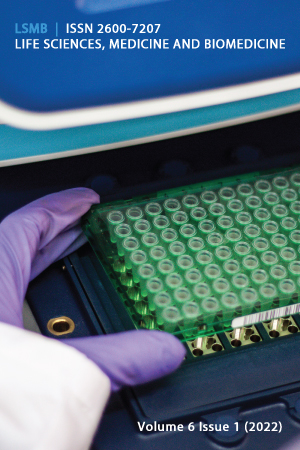Abstract
Human exposure to microplastics through inhalation has been widely reported in recent years. There is a paucity of work focusing on the direct effect of accumulation of microplastics in airways and how it may impact the respiratory function. This study aimed to investigate whether the exposure of microplastic would change the contractility of isolated airway smooth muscle tissue. Microplastics were obtained through milling of high-density polyethylene (HDPE) pellets by using a centrifugal mill. To confirm that the milled microplastic particle size range fell within the definition of microplastic, field-emission scanning electron microscope (FESEM) was employed. The milled microplastics particle size ranged from 44.2 µm to 552.4 µm. The organ bath technique was employed to study the direct change of tissue contractility of rat isolated tracheal rings. Tracheal rings were incubated with polyethylene microplastics of different concentrations (0.3 mg/ml to 10 mg/ml) for a minimum of 18 hours in physiological Krebs buffer, followed by the construction of concentration-response curves to a contractile agent, carbachol (muscarinic agonist). Exposure to all concentrations of polyethylene microplastics enhanced the contractile responses of the tissues to carbachol. However, the effect was only statistically significant in tissues incubated at 3 mg/ml and above (p < 0.05). Findings from this study provide preliminary evidence that exposure to polyethylene microplastics adversely affects airway function. Heightened contractile responses of airways mimic the pathophysiological responses in respiratory diseases such as asthma, chronic cough and chronic obstructive pulmonary disease. Further experiments focusing on the possible mechanism of actions of these microplastics affecting the airway tissue function are now needed.
References
Adyel, T. M. (2020). Accumulation of plastic waste during COVID-19. Science, 369(6509), 1314-1315.
https://doi.org/10.1126/science.abd9925
Amato-Lourenço, L. F., dos Santos Galvão, L., de Weger, L. A., Hiemstra, P. S., Vijver, M. G., & Mauad, T. (2020). An emerging class of air pollutants: Potential effects of microplastics to respiratory human health? Science of the Total Environment, 749 (2020), 141676.
https://doi.org/10.1016/j.scitotenv.2020.141676
Brahney, J., Mahowald, N., Prank, M., Cornwell, G., Klimont, Z., Matsui, H., & Prather, K. A. (2021). Constraining the atmospheric limb of the plastic cycle. Proceedings of the National Academy of Sciences, 118(16), e2020719118.
https://doi.org/10.1073/pnas.2020719118
Buels, K. S., & Fryer, A. D. (2012). Muscarinic receptor antagonists: Effects on pulmonary function. Handbook of Experimental Pharmacology 208, 317-341.
https://doi.org/10.1007/978-3-642-23274-9_14
Bustamante-Marin, X. M., & Ostrowski, L. E. (2017). Cilia and mucociliary clearance. Cold Spring Harbor Perspectives in Biology, 9(4).
https://doi.org/10.1101/cshperspect.a028241
Cooper, D. M., & Loxham, M. (2019). Particulate matter and the airway epithelium: The special case of the underground? European Respiratory Review, 28(153), 1-10.
https://doi.org/10.1183/16000617.0066-2019
Dong, C. di, Chen, C. W., Chen, Y. C., Chen, H. H., Lee, J. S., & Lin, C. H. (2020). Polystyrene microplastic particles: In vitro pulmonary toxicity assessment. Journal of Hazardous Materials, 385(2020), 121575.
https://doi.org/10.1016/j.jhazmat.2019.121575
Fadare, O. O., & Okoffo, E. D. (2020). Covid-19 face masks: A potential source of microplastic fibers in the environment. Science of the Total Environment, 737(2020), 140279.
https://doi.org/10.1016/j.scitotenv.2020.140279
Frias, J. P. G. L., & Nash, R. (2019). Microplastics: Finding a consensus on the definition. Marine Pollution Bulletin, 138 (2019), 145-147.
https://doi.org/10.1016/j.marpolbul.2018.11.022
Geiser, M., & Kreyling, W. G. (2010). Deposition and biokinetics of inhaled nanoparticles. Particle and Fibre Toxicology 7(2010),2.
https://doi.org/10.1186/1743-8977-7-2
Honeycutt, J. A., Nguyen, J. Q. T., Kentner, A. C., & Brenhouse, H. C. (2017). Effects of water bottle materials and filtration on bisphenol A content in laboratory animal drinking water. Journal of the American Association for Laboratory Animal Science, 56(3), 269-272.
https://pubmed.ncbi.nlm.nih.gov/28535862/
Li, L., Zhao, X., Li, Z., & Song, K. (2021). COVID-19: Performance study of microplastic inhalation risk posed by wearing masks. Journal of Hazardous Materials, 411(2021), 124955.
https://doi.org/10.1016/j.jhazmat.2020.124955
Loong, B. J., Tan, J. H., Lim, K. H., Mbaki, Y., & Ting, K. N. (2015). Contractile function of smooth muscle retained after overnight storage. Naunyn-Schmiedeberg's Archives of Pharmacology, 388(10), 1061-1067.
https://doi.org/10.1007/s00210-015-1140-3
Pang, L.Y., Sonagara, S., Oduwole, O., Gibbins, C., & Ting, K.N. (2021). Microplastics - an emerging silent menace to public health. Life Sciences, Medicine and Biomedicine, 5(10).
https://doi.org/10.28916/lsmb.5.1.2021.72
Prata, J. C. (2018). Airborne microplastics: Consequences to human health? Environmental Pollution, 234(2018), 115-126.
https://doi.org/10.1016/j.envpol.2017.11.043
Prata, J. C., da Costa, J. P., Lopes, I., Duarte, A. C., & Rocha-Santos, T. (2020). Environmental exposure to microplastics: An overview on possible human health effects. Science of the Total Environment, 702(2020), 134455.
https://doi.org/10.1016/j.scitotenv.2019.134455
Ruan, Y. C., Zhou, W., & Chan, H. C. (2011). Regulation of smooth muscle contraction by the epithelium: role of prostaglandins. Physiology, 26(3), 156-170.
https://doi.org/10.1152/physiol.00036.2010
Thomas, R. J. (2013). Particle size and pathogenicity in the respiratory tract. Virulence 4(8), 847-858.
https://doi.org/10.4161/viru.27172
Vianello, A., Jensen, R. L., Liu, L., & Vollertsen, J. (2019). Simulating human exposure to indoor airborne microplastics using a Breathing Thermal Manikin. Scientific Reports, 9(1), 1-11.
https://doi.org/10.1038/s41598-019-45054-w
Wright, S. L., Ulke, J., Font, A., Chan, K. L. A., & Kelly, F. J. (2020). Atmospheric microplastic deposition in an urban environment and an evaluation of transport. Environment International, 136(2020), 105411.
https://doi.org/10.1016/j.envint.2019.105411
Zhang, Y., Kang, S., Allen, S., Allen, D., Gao, T., & Sillanpää, M. (2020). Atmospheric microplastics: A review on current status and perspectives. In Earth-Science Reviews, 203(2020), 103118.

This work is licensed under a Creative Commons Attribution 4.0 International License.
Copyright (c) 2022 Ting Kang Nee, Nurshafida Adzlin Shamsul Anuar, Li-Yin Pang, Sivathass Bannir Selvam, Christopher Neil Gibbins

